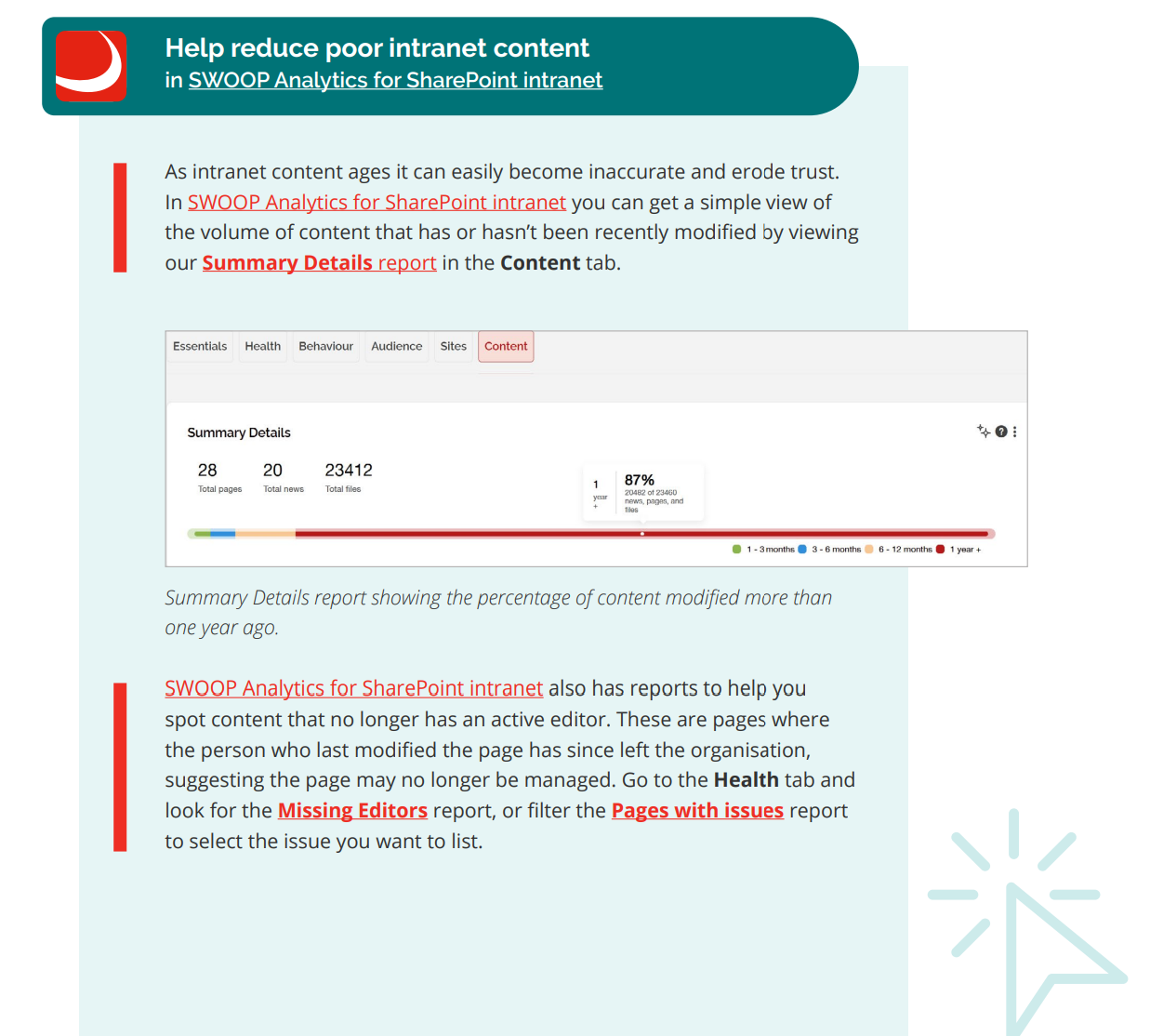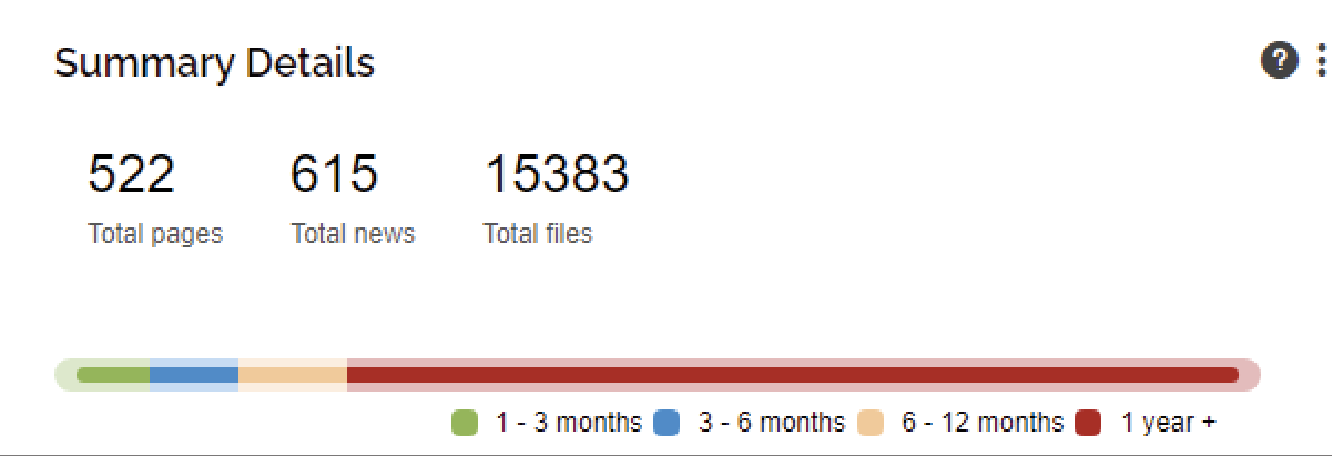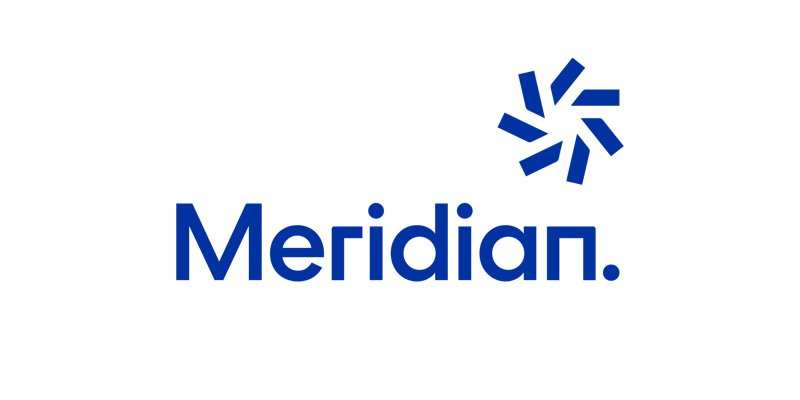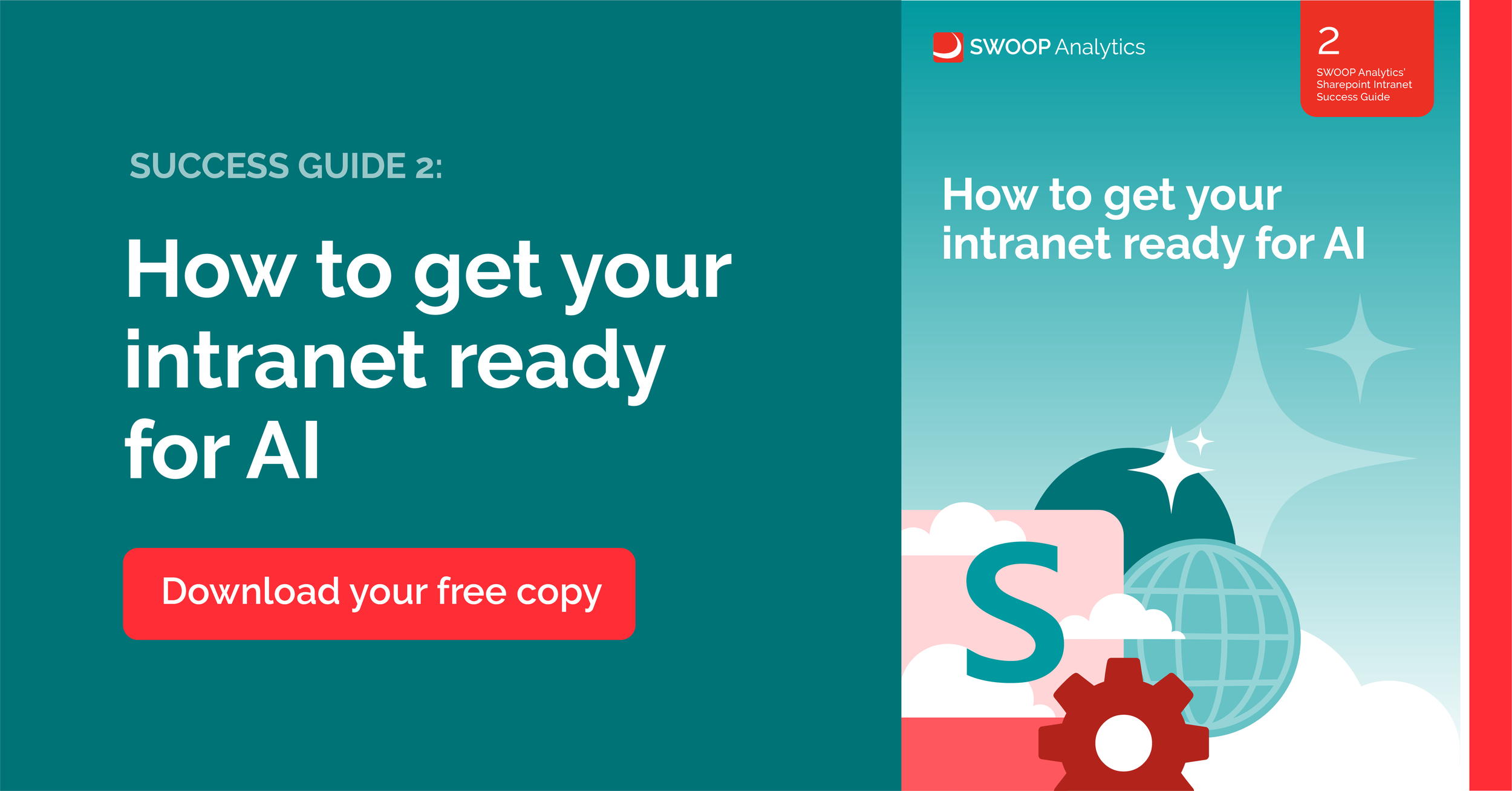Are intranets ready for generative AI?
You might have heard the murmurs and whispers; “Will AI take over the intranet?”
Given the speed in which AI tools are advancing, it’s a fair question. As part of SWOOP Analytics’ 2025 SharePoint intranet benchmarking research, we contacted many of the 28 organisations involved in the study, as well as many more, to ask how they are currently using AI, along with their predictions on how AI will impact intranet content and usage.
The overwhelming consensus is that AI and the intranet won’t work together unless governance measures are in place and content is up to date.
When content is up to date and effectively governed, AI can be helpful in summarising content and information, thereby saving time.
Some organisations we contacted are trialling bots on their intranet to help employees find the information they’re looking for, rather than having to navigate across the entire intranet. Again, the caveat for this to work is that content must be up to date to provide the correct information and effective information management practices must be followed. Most respondents said using AI to answer people’s questions on topics like leave entitlement and company policies would be invaluable.
Most people we surveyed have tested, or are using, AI to help produce intranet content. One respondent said AI already saved her a few hours a week in reading and collating content. Others said AI is game changer with transcriptions of videos and interviews. AI also has the potential to help people who are non-professional writers better produce articles for the intranet. But every internal communications professional we surveyed agreed any content produced by AI needs to be checked for accuracy and, if you want people to engage with content, it needs to be rewritten with a catchy angle.
The key takeaways from our interviews and surveys:
Intranet content must be up to date for AI to be helpful.
Any content produced by AI needs to be checked for accuracy.
AI-produced content needs to be rewritten to make it engaging for colleagues to interact with.
To ensure accuracy, effective information management practices, including naming conventions, archiving documents, setting permissions and sensitivity on documents, must be adhered to.
The quality and accuracy of intranet content is a matter of priority. The promise of AI requires content to be valid, and if you have a poorly maintained intranet with a large proportion of outdated content, you need to be able to exclude it from your AI solution.
How organisations are currently using AI for intranets and preparing for the future
Many intranets have been described as a jungle of aged, incorrect content which leads to misinformation when using AI. This is often because content is old and out of date, or poor information management practices are in place, so ensuring content on your intranet is accurate is a priority.
Arqiva
Helen Nias, Digital Communications and Channels Manager at British technology services business Arqiva, recognises the importance of accurate information across all intranet pages and files, and is currently trying to sift through thousands of pages and files to ensure information is up to date. This enormous task means using AI across Arqiva’s SharePoint intranet may be some time away.
As a starting point to this task, Helen uses SWOOP Analytics for SharePoint intranet to identify the number of content pages, news pages, files, and their lifespan on SharePoint Online.
“I am currently working hard to get our intranet up to date,” Helen said.
“It’s my top priority this quarter and I’m running training sessions with content owners and trying to get them to take some responsibility.”
Once the intranet is up to date, Helen wants to tackle correct labelling of content and archiving processes as the next step before thinking about introducing AI tools.
A screenshot of Arqiva’s intranet content Summary Details from SWOOP Analytics for SharePoint intranet.
NRMA
It’s a similar situation at Australia’s largest member organisation the NRMA. Elena Sergis, Digital Workplace Manager at the NRMA, said; “AI very much feels like the boiling hot topic at the moment, it’s like a shadow everywhere I go!” and the priority is to get content up to date in preparation for AI.
“This is our focus - centralising our intranets with strong governance so that content is up to date,” she said.
This is with a view towards eventually using Copilot agents across the NRMA’s intranet. Copilot agents is Microsoft’s specialised AI assistants designed to enhance Copilot by connecting organisation’s internal knowledge and data sources.
“I would love a Copilot agent over our site, but we are just not there yet,” Elena said.
Anonymous national financial regulator
The use of AI at this national financial regulator is currently limited, given the sensitive information being dealt with across the federal government entity.
“We are currently trialling Copilot but prompts, responses, and data accessed is not used to train the AI outside of (our organisation) ensuring that proprietary over our data remains confidential,” said the Senior Communications Advisor at this financial regulator.
She said she has used Copilot to create draft stories, plans and schedules as part of her trial and experimentation.
“I don’t think it will be replacing our intranet yet as it still needs human oversight to ensure information is correct and presented in a way that captures a reader’s attention,” the Senior Communications Advisor said.
“I’ve also used it to quickly simplify technical regulatory language, so we write our intranet stories for a broader audience (but note I still I have to edit).”
In its present form, the Senior Communications Advisor said AI and Copilot is more a “productivity enabler”.
“I do use it to collate information and give me a starting point to produce what we need to produce,” she said.
“Currently it’s saving me a few hours per week in reading and collating.”
The Senior Communications Advisor said AI is a great tool for the neurodiverse community, especially for anyone who might struggle to get started on producing content.
“A couple of prompts starts the ball rolling and means you can get right on with reviewing and editing, removing a lot of the collating of all the information,” she said.
However, the Senior Communications Advisor listed her current concerns about Copilot and why she says it still needs human oversight:
Accuracy – information can be incorrect or out of date.
Outputs are repetitive. Often text repeatedly contains the same information, written in different ways.
While content produced can provide basic information, it doesn’t create an interesting angle that captures attention on the intranet. This is where the human touch is essential.
Copilot-generated images are bad.
As an aside, the Senior Communications Advisor tells the funny story of using Copilot and prompting it to write an “intranet story” on a particular topic.
“And the story produced started; ‘Once upon a time…’,” she said.
“I learned that the prompt needs to include ‘intranet article’ rather than ‘intranet story’.” 🤣
New Zealand-based financial organisation
A New Zealand-based financial organisation is currently working to produce a “reliable source of curated information” to power an AI solution.
“And because in our AI adoption the onus is on the person using AI to verify the output is correct, we’ll still also need a usable way for people to check that the AI is steering them right,” said the respondent from the NZ-based organisation, who chose to remain anonymous.
“We are just kicking off a proof of concept to explore some of this, using AI as a chatbot to serve up content from our intranet to our frontline teams in order to help them more easily find what they need when serving our customers.
“It’s very early days but I’m excited to see what we can learn from this experiment.”
Meridian Energy
Robert Johnson, Internal Communications Manager at New Zealand’s Meridian Energy, sees a huge potential benefit when it comes to internal communications and making information more easily accessible on platforms including SharePoint intranet.
While he can’t yet speak to specific examples, Robert listed instances where he and his colleagues utilise AI to help produce content:
Summarising content: Often we can receive content which is long-form and needs to be summarised. AI is a great starting point for this to quickly condense the material and allow us to edit and polish. While it is quick and makes a start, it's not perfect and always needs a human eye over it as a final touchpoint.
Transcription and text-based video editing: We enjoy creating short videos as part of our internal communication suite and AI is helping to speed up our workflow. We're able to load a Microsoft Teams interview into Copilot to produce a transcript, work with AI to produce a short script or video flow, then utilise the provided script to cut the video. It saves a lot of time trawling through multiple video clips to find the sentences you want in the final edit.
Capturing actions and brainstorms: We often have brainstorm sessions over Microsoft Teams and record it so Copilot is our note taker and can help organise our thoughts and ideas into actions or rough plans following our chat. It's never going to replace creating a comms plan from scratch but the time it saves capturing key points and actions means we can dive into developing a plan and tactics a lot faster than normal.
Similar to Elena from NRMA, Robert sees a lot of value in Copilot agents and how they can make content more accessible across the SharePoint intranet.
“It provides staff a new way to discover information and takes out the guess work around where content might traditionally sit within an intranet structure,” Robert said.
“When we think about how internal comms can make life easier for staff and reduce the time it takes to find relevant documents or news, this looks really promising.
“It's early days though and it still relies on having the right information up to date and stored in the right place, but it is something we will continue exploring and keeping an eye on how the technology progresses.
“Utilising AI agents looks to be a really valuable tool when we think about intranets and internal knowledge hubs that are used in certain areas of the business.”
AustralianSuper
Laura Hamilton, former Manager, Internal Communications Channels at Australia’s largest superannuation fund AustralianSuper, said while AI isn’t being used for the intranet yet, occasionally the internal communications team suggests intranet content owners use Copilot to help them write content.
“I think using AI to support people to write content could be a game changer,” Laura said.
“So often in a decentralised publishing model the people writing the content are not skilled communicators and don't know how to approach the content from the user perspective. This often results in too much information, not enough information, and content that is unclear (uses too many acronyms, makes assumptions about user knowledge, etc).
“I think AI could support content owners to create much better content, but I think it would require something more dedicated than just Copilot.”
Laura listed other benefits she anticipates from AI:
Reducing duplication of content
Improving information architecture and the navigation experience
Helping to group like-content, suggesting related links and next steps
Providing a personalised navigation experience based on the user's role, location, interests, without the clunkiness of an intranet administrator setting these up manually
Creating aesthetically pleasing pages that are functional. Rather than page templates, a user could focus on providing the content (text, images, docs - with AI support), and AI would lay out the information on a page in a way that is easy for users, consistent with other pages and providing a pleasing viewer experience.
Laura says the danger in AI for intranets lies in the way; “it feels like an authoritative source of information for users, but it's reliant on the information it has access to, and that information is so often out of date, and may lack context.
“Even when the information is accurate, summarising information could lead to an interpretation of the information that is incorrect, and there's no sanity check on what AI is actually providing to employees.
“Essentially, I think AI could be a great tool to help employees write, display and navigate to information, but I don't think it can be a replacement for these accessible sources of content, and intranets are very much still required.”
Australian state government department
Like Meridian Energy, this large Australian state government department, which is remaining anonymous, is currently testing Microsoft Copilot.
The manager for online engagement at this department said he is unaware of any use of AI across the intranet, but he would like to see a series of prompts developed to improve content creation for the intranet.
“This is where the focus will need to be rather than letting people have an uneven spectrum of prompts that they improve the content/user experience/design,” he said.
Like many other respondents, this manager is interested in exploring Microsoft agents across the intranet.
“I certainly see the opportunity for intranets to adopt this to essentially replace their search with a Copilot window that accesses only the information on an intranet, and possibly only the information that is corporately approved,” he said.
“This would drive improvements in quality management by having people wanting to include their information in the ring-fenced information and increase the move towards a more language-based interface for information on an intranet.”
Looking to the future, this manager predicts the use of intranets will change, with employees using it to ask questions, rather than search for information.
“Currently intranets are really focused on the architecture of the site and look and feel, and I believe this will change (not straight away) where people will be using an interface similar to ChatGPT where they just ask a question and the information is surfaced up rather than search that just links to the page,” he said.
“This means that the way we write content for intranet needs to adapt to allow AI queries to return the best results so we will be seeing a style change there.”
This manager believes AI could be a game changer for accessibility.
“The big winner from AI is in accessibility space, with the tools available now allowing people to improve the capability of content developers to write in an accessible way, as well as allowing those that rely on accessible formats to access content the way they need,” he said.
“This also extends to people where English is not the first language, allowing them to get information in a language that they are more comfortable with.”
YNV Group
Christos Kaleris, Internal Communications Manager at YNV Group, said he already primarily uses AI to write intranet content.
“I use it to build the skeleton of the content and then add the ‘human touch’, as I like to say,” he said.
“It saves me tons of time and it’s becoming better very fast.”
Christos also uses AI to summarise content and translate an external article to share internally in Greek.
In keeping with many other respondents, Christos would love to see AI used to allow employees to ask questions and receive accurate answers.
“I would love to use AI on the intranet as a 24/7 assistant in various areas,” he said.
“I would want to answer to my simple employee questions from holidays to policies and even company information available on the intranet.”
But Christos predicted it will be some time before AI is capable of replacing intranets, especially those using SharePoint intranets.
“It (AI) will advance the capabilities and its interface, it will be able to help owners and content editors a lot, but building an intranet for different target groups and with engagement in mind is such a human and complex task that AI would not be able to do it alone,” he said.
“It needs constant attention and improvement to cater to employees' needs and new trends."
SWOOP Analytics contacted many more organisations to ask about their AI readiness for their intranets. Some large multinationals have built prototypes that have been fed selected internal content. Employees can ask questions about things like annual leave and receive translations, and to date, the response has been positive.














